Figure EV2. Entrainment deficiency of CRY‐deficient mice to environmental light:dark cycles and Timeless‐independent protein rhythms in Drosophila melanogaster .

-
ARepresentative actograms showing that CKO mice (n = 5) cannot be entrained to 8 h:8 h or 12 h:12 h light:dark cycles, whereas WT mice entrain to 12 h:12 h but not 8 h:8 h light‐dark cycles (n = 5). Equal numbers of age‐matched male and female mice were used.
-
B, CFor CKO mice during under LD cycles, the dominant period of behavioural rhythms is determined by the period of the zeitgeber, whereas amplitude does not vary significantly between 16‐h and 24‐h cycles. In contrast, the period of WT behavioural rhythms does not vary significantly between 16‐h and 24‐h cycles, whereas amplitude is significantly reduced under unnatural 8 h:8 h light:dark cycles. This indicates the robustness conferred by CRY to circadian rhythms of locomotor activity in WT mice in vivo. Two‐way ANOVA P‐values and significance from Sidak’s multiple comparisons test are reported; horizontal line represents mean.
-
DNormalised, detrended bioluminescence recording of the XLG‐luciferase reporter (XLG‐LUC; equivalent of PER2::LUC) expressed in WT and timeless knockout (Timout) flies under constant darkness (detrended means ± SEM; WT n = 21, Timout n = 36). Note the difference in y‐axis scaling.
-
EDamped sine wave fit to the data presented in (D). P‐values (extra sum‐of‐squares F‐test) indicate comparison of fit test with the null hypothesis (straight line).
-
FSignificant differences in the period and amplitude of XLG‐LUC rhythms of Timout compared with WT flies. Mean ± SEM, P‐values indicate unpaired t‐test, WT n = 21, Timout n = 36.
Data information: The generation of Timout flies is reported in Lamaze et al (2017). Similar to CRY‐deficient mice, whole gene timeless knockout flies are characterised as being behaviourally arrhythmic under constant darkness following entrainment by light:dark cycles: https://opus.bibliothek.uni‐wuerzburg.de/frontdoor/index/index/year/2015/docId/11914
